Mexico’s Day of the Dead celebration this weekend won’t be the same in a year so marked by death, in a country where more than 90,000 people have died of COVID-19.
Many of those had to be cremated rather than buried, and even for those with gravesides to visit, the pandemic has forced authorities in most parts of Mexico to close cemeteries to prevent the traditional Nov. 1-2 observances when entire families clean and decorate tombs, cover them with orange marigolds, light candles and chat with their deceased relatives, perhaps over a glass of their favorite beverage.
On Sunday, many residents of the impoverished suburb of Valle de Chalco, east of Mexico City, visited to a recently opened overflow section of the local cemetery to clean the simple graves of their loved ones — many still just marked by dirt mounds — because they had heard the graveyards would be closed on the actual holiday. “A lot of people came to fix up their (relatives’) graves before the Day of the Dead,” said José Juan Rivera Almazán, the cemetery manager.

Graves are decorated with crosses and grass in a section of the municipal cemetery Valle de Chalco amid the new coronavirus pandemic, on the outskirts of Mexico City, Sunday, Oct. 25, 2020. Mexican families traditionally flock to local cemeteries to honor their dead relatives as part of the "Dia de los Muertos," or Day of the Dead celebrations, but according to authorities the cemeteries will be closed this year to help curb the spread of COVID-19. (AP PhotoMarco Ugarte)
He noted the new section of the graveyard “is filling up quickly. We do not know if that’s because of the disease,” though it is clear there is a steady trickle of new burials of COVID victims; they are easy to recognize because their coffins come wrapped in plastic.
On a normal Day of the Dead, Rivera Almazán said, “You can’t even walk through here, it is so full, people, visitors, vendors’ stands.”
This year, though, the cemetery will be quiet.
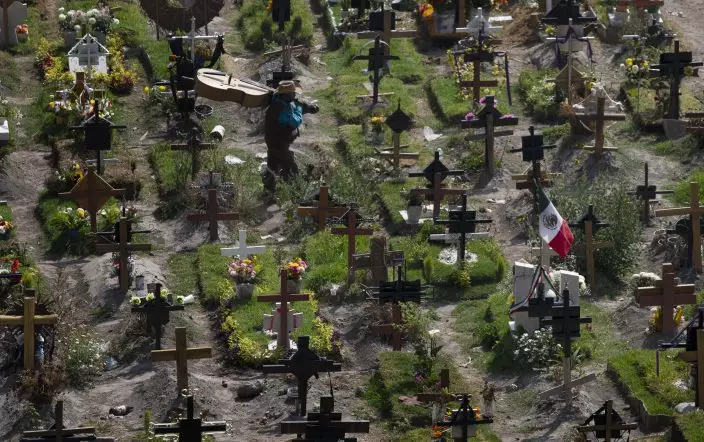
A musician walks through the municipal cemetery Valle de Chalco amid the new coronavirus pandemic, on the outskirts of Mexico City, Tuesday, Oct. 20, 2020. Mexican families traditionally flock to local cemeteries to honor their dead relatives as part of the “Dia de los Muertos,” or Day of the Dead celebrations, but according to authorities the cemeteries will be closed this year to help curb the spread of COVID-19. (AP PhotoMarco Ugarte)
Jacinta Jiménez Viviano lost her husband, retired manual laborer Vicente Domínguez Alejo, to COVID-19 this year. He died in the hospital, after almost no visits; Jacinta was occupied with her son, who also fell ill but recovered. Her husband, a diabetic, was not so lucky.
Knowing she would not be able to come on Nov. 2 — when deceased adults are honored — she brought flowers Sunday to plant at her husband’s dusty grave. She said the simple act of tending the grave was reassuring.
“I feel this represents hope that we will make it because, thank God, these days of the dead are very important to Mexicans,” Jiménez Viviano said. “We will leave a little offering for him now, and later, when we can, we will return.”

Cemetery worker Jorge Arvizu plants a rose bush on a grave at the municipal cemetery Valle de Chalco amid the new coronavirus pandemic, on the outskirts of Mexico City, Tuesday, Oct. 20, 2020. Mexican families traditionally flock to local cemeteries to honor their dead relatives as part of the “Dia de los Muertos,” or Day of the Dead celebrations, but according to authorities the cemeteries will be closed this year to help curb the spread of COVID-19. (AP PhotoMarco Ugarte)
Mexico has long had a different attitude toward death, more social, more accepting than in many parts of the world. Wakes and funerals here are often elaborate, days-long events gathering entire neighborhoods and extended families for eating, praying and remembering.
But death amid the pandemic has become a very lonely affair; not only were wakes prohibited, many families couldn’t be with their relatives in their final moments or even view the body because of the coronavirus.
But in some ways, this year’s Dia de Muertos has also taken the holiday back to its roots and stripped away many of the cultural overlays and modern innovations that had begun influencing the celebration in recent years.
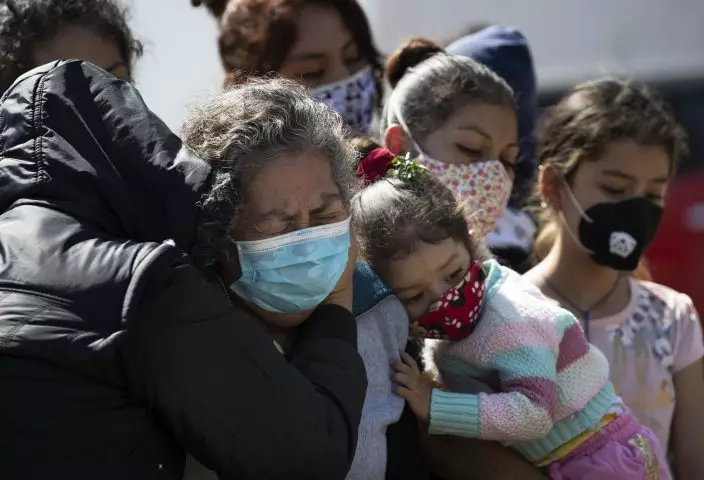
Relatives bury Isaac Nolasco who died of reasons not believed related to COVID-19, in a section of the municipal cemetery Valle de Chalco amid the new coronavirus pandemic, on the outskirts of Mexico City, Sunday, Oct. 25, 2020. Mexican families traditionally flock to local cemeteries to honor their dead relatives as part of the "Dia de los Muertos," or Day of the Dead celebrations, but according to authorities, the cemeteries will be closed this year to help curb the spread of COVID-19. (AP PhotoMarco Ugarte)
Gone is the Hollywood-style Day of the Dead parade that Mexico City adopted to mimic a fictitious march in the 2015 James Bond movie “Spectre.” Halloween, with its more risky, group activities — costume parties and trick-or-treating — has retreated in the face of the pandemic.
In many ways, it has boiled down to the way the holiday began: simple altars to invite the dead to come home for a night, featuring candles to guide the spirits back and the favorite food and drink of the dead to lure them home. Held inside homes, this is one of the few safe activities, though there are some attempts at online celebrations too.
“This year, the Day of the Dead must be celebrated virtually,” said Mexico City cultural secretary José Alfonso Suárez del Real, inviting city residents to post photos or videos of their altars on a city website. “It is fundamental that we recover and adopt once again the altars to our dead, which are household altars.”

A cemetery worker digs a grave at the municipal cemetery Valle de Chalco amid the new coronavirus pandemic, on the outskirts of Mexico City, Tuesday, Oct. 20, 2020. Mexican families traditionally flock to local cemeteries to honor their dead relatives as part of the “Dia de los Muertos,” or Day of the Dead celebrations, but according to authorities the cemeteries will be closed this year to help curb the spread of COVID-19. (AP PhotoMarco Ugarte)
One of the country’s largest funeral homes, Gayosso, has launched “Lazos,” an online system for sending flowers directly to graves and mausoleums. And, with cemeteries and mausoleums closed due to the risk of infection from COVID-19, the company offers online Masses for the departed.
It’s not the same.
“In one way or another, they are taking away our ancestral tradition ... a tradition that has never before been cancelled,” said Ericka Alejandra Alvarez, an ethnohistorian at Mexico’s National Autonomous University. “This is going to cause a shock in society; people are going to be upset, uncomfortable, not happy.”
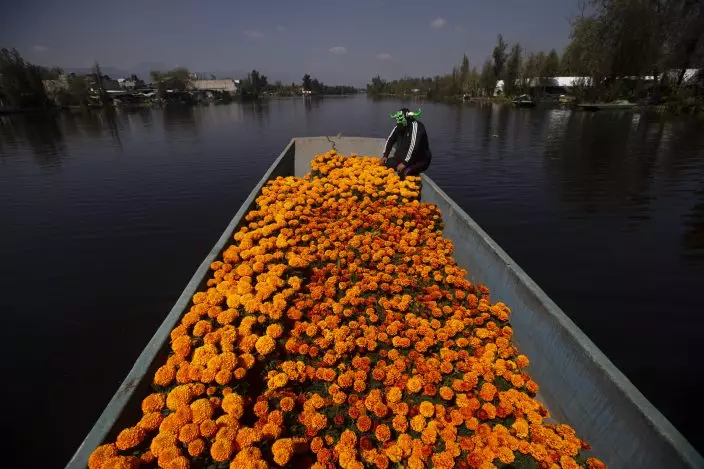
Mexican wrestler Mister Jerry floats with a boatful of marigold flowers in the famous floating gardens of Xochimilco, on the outskirts of Mexico City, Wednesday, Oct. 14, 2020. The harvest of Mexican marigold flowers known as Cempasuchil in the Nahuatl language is done ahead of the Nov. 1, Day Of The Dead holiday. (AP PhotoMarco Ugarte)
Born of pre-Hispanic rituals that may have lasted 20 days, and combined with European elements brought by the Spaniards, Day of the Dead is rooted in the idea that the spirits of the dead should know they are loved and have a home; if they don’t, they might wander aimlessly.
This has led to sometimes strange and elaborate preparations. In some towns and neighborhoods, families tend small fires outside their homes and spread trails of marigold petals to the door to guide the spirits. In some Indigenous towns, the bones of ancestors are annually taken from ossuary niches to be cleaned around the Day of the Dead.
“It is not just going to a tomb to leave an offering or lay some flowers there,” said Alvarez. “Everything that we Mexicans do regarding death is cathartic, because you cry, your soul breaks,” she noted. “All this catharsis you go through with the symbols that make up a funeral, they are important because they give you the sense and the understanding of death, and that isn’t there anymore" because the cemeteries are closed.
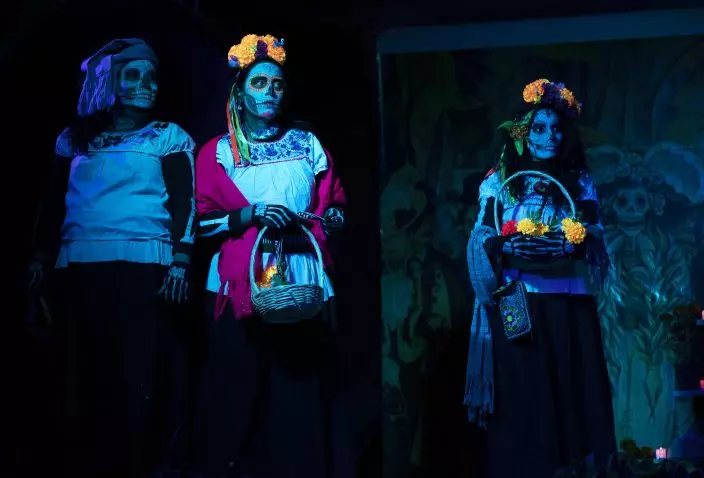
Women dressed as "Catrinas" perform in a play promoting the upcoming Day of the Dead holiday, in the Xochimilco borough of Mexico City, Friday, Oct. 23, 2020. The iconic figures of skeletons with elegant wide-brimmed hats better known as Catrinas were created as satirical prints by Mexican artist Jose Guadalupe Posada sometime between 1910 and his death in 1913. (AP PhotoMarco Ugarte)
“So how are we going to do it? I say that we should do it, not in crowds, or collectively, but in our own homes,” she said. “If we can’t go to the cemeteries, we have to put up our altars.”
Those are often crowded affairs, reflecting all of a family’s deceased. This year Alvarez’s will be dedicated to two brothers who died years ago as children, to her three uncles and grandparents.
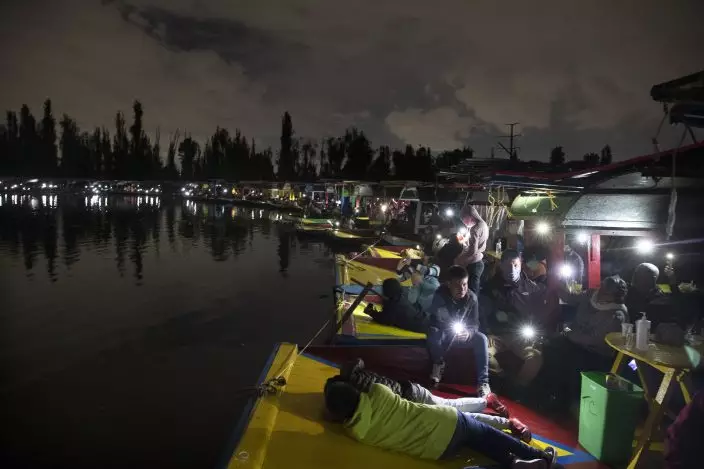
People cast the light of their cellphones from their trajinera boats as they watch the play La Llorona performed on top of a chinampa, a small artificial island at Cuemanco pier in Xochimilco, Mexico City, late Friday, Oct. 9, 2020, as the city promotes the upcoming Day of the Dead holiday at the end of the month, amid the COVID-19 pandemic. Legend has it that La Llorona drowned her children and then regretfully looks for them in rivers and towns, scaring locals who can hear her at night. (AP PhotoMarco Ugarte)
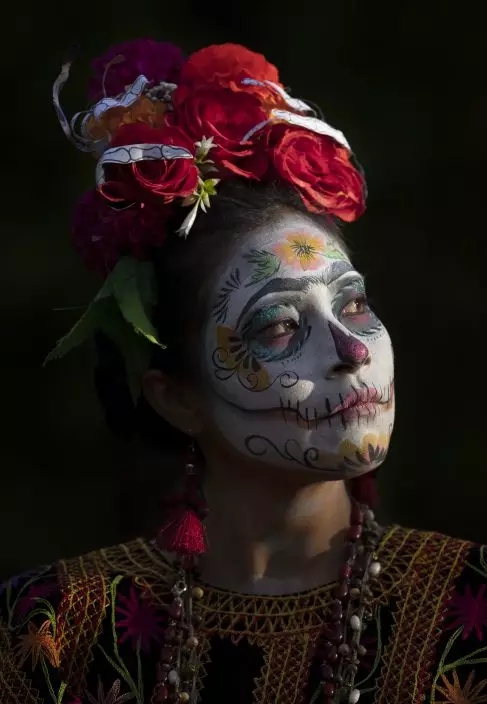
Gabriela Ruiz is dressed as a "Catrina" to perform in a play promoting the upcoming Day of the Dead holiday, at the Nativita pier in the Xochimilco borough of Mexico City, Friday, Oct. 23, 2020. The iconic figures of skeletons with elegant wide-brimmed hats better known as Catrinas were created as satirical prints by Mexican artist Jose Guadalupe Posada sometime between 1910 and his death in 1913. (AP PhotoMarco Ugarte)

Actress Nayeli Cortes dressed as the La Llorona character, carries a doll representing her child as she performs in the play La Llorona on top of a chinampa, a small artificial island at Cuemanco pier in Xochimilco, Mexico City, late Friday, Oct. 9, 2020, as the city promotes the upcoming Day of the Dead holiday at the end of the month, amid the COVID-19 pandemic. Legend has it that La Llorona drowned her children and then regretfully looks for them in rivers and towns, scaring locals who can hear her at night. (AP PhotoMarco Ugarte)


